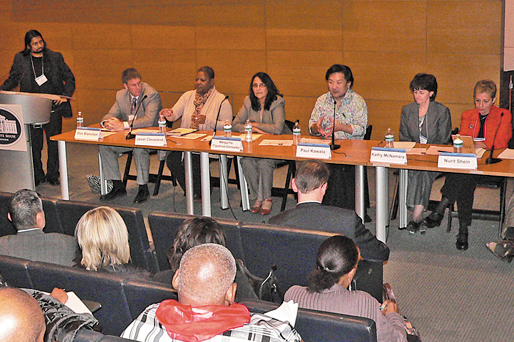Local and national HIV/AIDS experts, advocates and activists gathered at the University of Pennsylvania last week to share ideas and information about the shifts in store for the HIV funding landscape.
“Sustaining the Community-Based Response to HIV” was the third in a series of recent public forums staged by the Office of National AIDS Policy to address the impacts of the implementation of the National HIV/AIDS Strategy and the Affordable Care Act.
“It’s pretty clear that things are changing,” said Kevin Burns, Action AIDS executive director.
One major change covered in the discussion was the future of the Ryan White Care Act, which provides HIV-related services to those who are un- and under-insured.
Beginning in 2014, the ACA will allow for many of those currently receiving treatment under Ryan White-funded programs to be insured under Medicaid or Medicare, leaving the reauthorization of the Ryan White program up in the air.
“That’s huge, politically, ideologically and implementation-wise,” said Dr. TJ Ghose, assistant professor at Penn’s School of Social Policy & Practice and moderator of the panel discussion. “There is a sea change taking place in funding, probably the biggest changes since Ryan White Care was introduced.”
With the possible loss of Ryan White funding, community-based HIV/AIDS agencies will be left to seek other outlets, which could come in the form of organizational collaborations.
Through the ACA, new funding will be available to Federally Qualified Health Centers — agencies that provide a continuum of care, not specific to one population or one disease, regardless of a patient’s ability to pay.
Both Mazzoni Center and Action AIDS were recently awarded grants to begin the process of applying to become FQHCs.
“We figured out a couple years ago that the federal government was moving in this direction so we started moving Mazzoni Center toward not just having the medical practice but becoming an FQHC,” said Mazzoni executive director Nurit Shein. “But my fear is for the smaller organizations that have relied mostly on Ryan White dollars. What’s going to happen to them?”
Burns said local HIV/AIDS service organizations are going to be facing some “tough decisions” in the future, which are likely to change the face of the ASO community.
“We have to look at how we can work together,” he said. “We may have to merge some organizations that would struggle more to stay in existence because of their size. We have to do some strategic thinking as ASOs about how we can protect the services we all offer, which is the bottom line — we need to be offering quality services. So we need to talk about partnerships and mergers in a civilized way that will serve our clients best.”
One form of potential partnership is the “health home” structure.
ACA authorized states to create networks of providers that will offer integrated services for Medicaid recipients.
“The onus is on collaboration,” Ghose said. “Previously, with the Ryan White Care funding, agencies would compete for the same pot of money, but now it’s looking more like the organizations are going to have to go for the funding in a team. If Agency A is better set up for one piece and Agency B is better set up for another service, instead of competition they now need to move toward being collaborating partners. Basically, the need of the hour is to start the conversation in our community with Community Health Centers and Federally Qualified Health Centers to get into these networks and create teams that can utilize ACA funding for HIV care.”
While last week’s panel discussion made the case for continued conversation on funding issues, it also raised numerous questions that will need to be considered as HIV care in the nation develops.
For instance, Ghose noted that the integration of HIV-related care into mainstream facilities will require an evaluation of HIV/AIDS education and awareness among mainstream providers.
“Ryan White was created largely because health centers were not able to handle HIV care: There was homophobia, all kinds of biases and stigma, and many doctors just weren’t ready to address the psychosocial and medical needs of the patients,” Ghose said. “But now, HIV care is moving into the generalized health centers, so we have to ask the question of, is this stigma dealt with?”
Another outstanding question includes the availability of health coverage for those who have been incarcerated.
Currently, when someone becomes incarcerated, he or she is terminated from Medicare or Medicaid and faces an uphill battle to restore the coverage after release, Ghose said, which could be especially problematic for those with HIV/AIDS.
“Incarceration contributes heavily to the HIV disparity rates between African Americans and whites,” he said. “So what will happen to these people? The federal government needs to come out with guidelines saying that incarceration will not delist you from Medicaid because otherwise there’s going to be an even larger segregation among people of color and those at risk for incarceration.”
With ACA implementation just over two years away, Shein said HIV agencies need to mobilize to get answers to the myriad questions the new law is raising and organize for optimum outcomes.
She said, “2014 is just around the corner. We really need to be advocates for the Ryan White dollars continuing to be there. We need to show the federal government the value of the Ryan White model and be really proactive in providing information through the systems that are now soliciting public comment so that all of our voices can be heard.”
Jen Colletta can be reached at [email protected].
